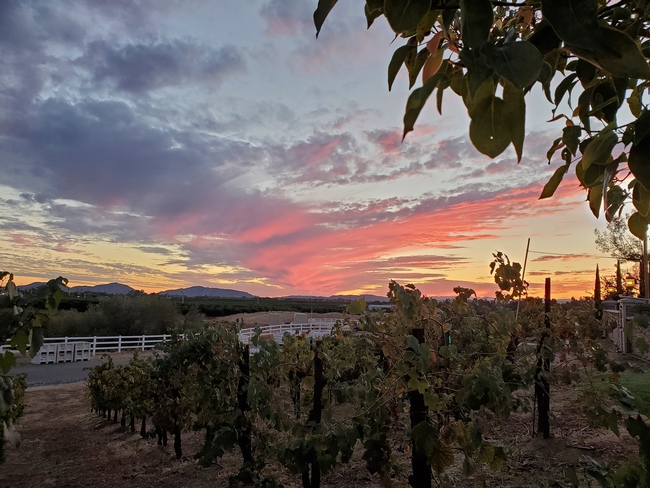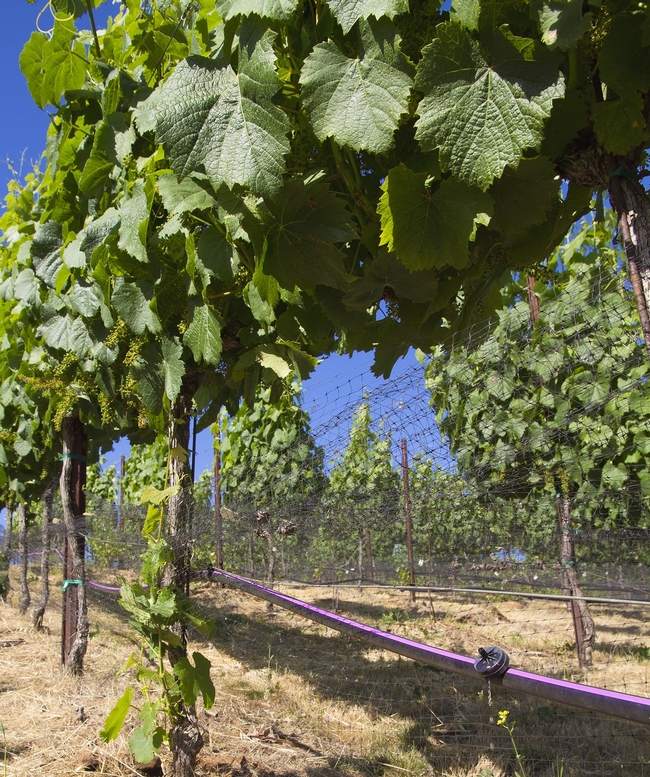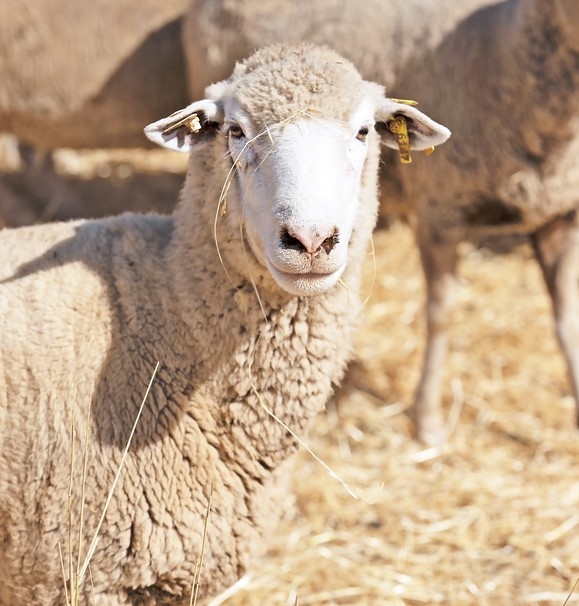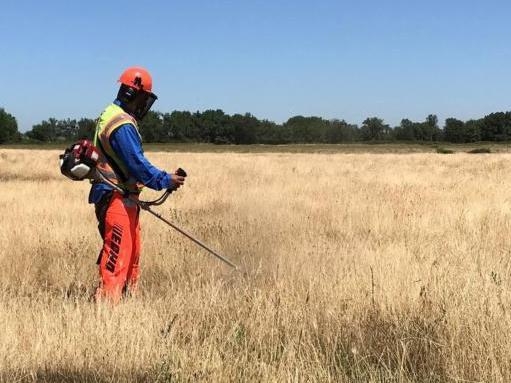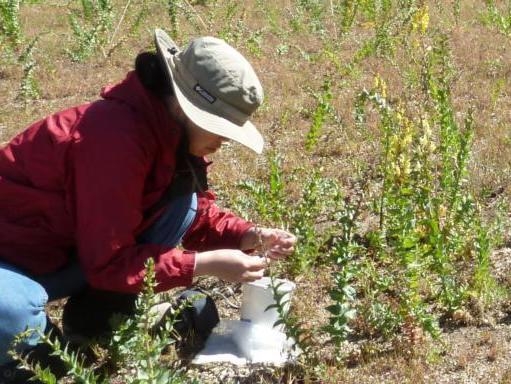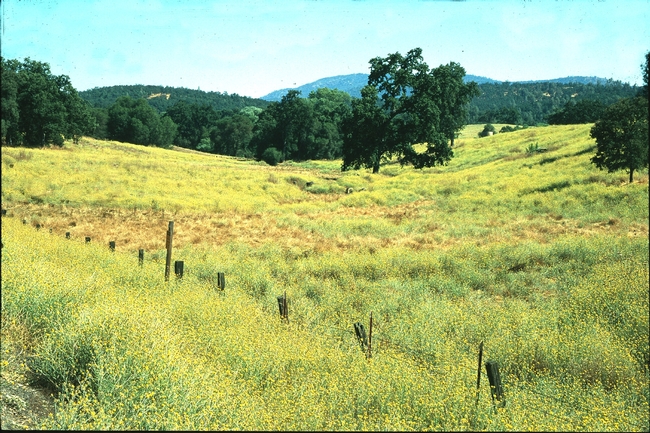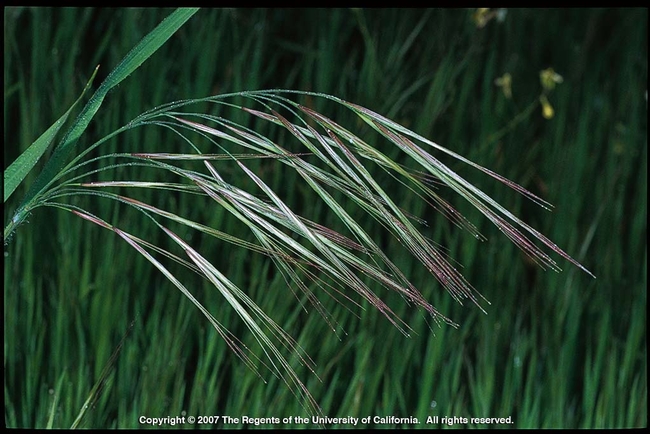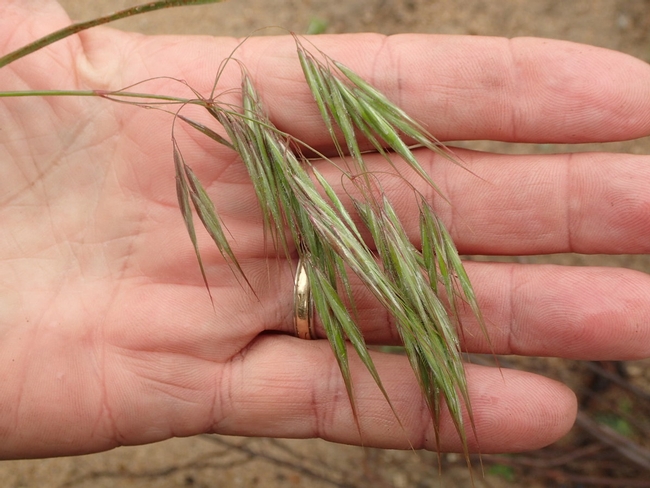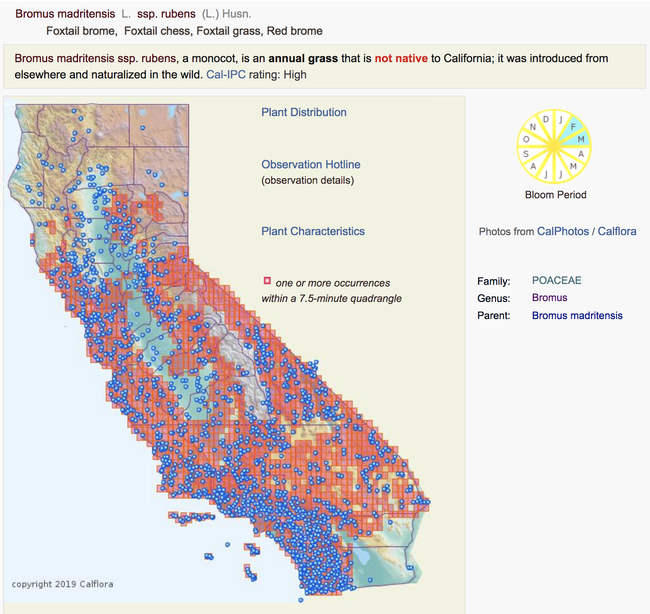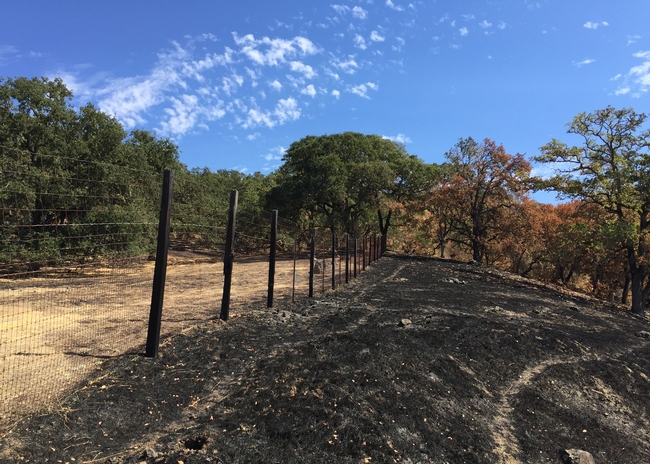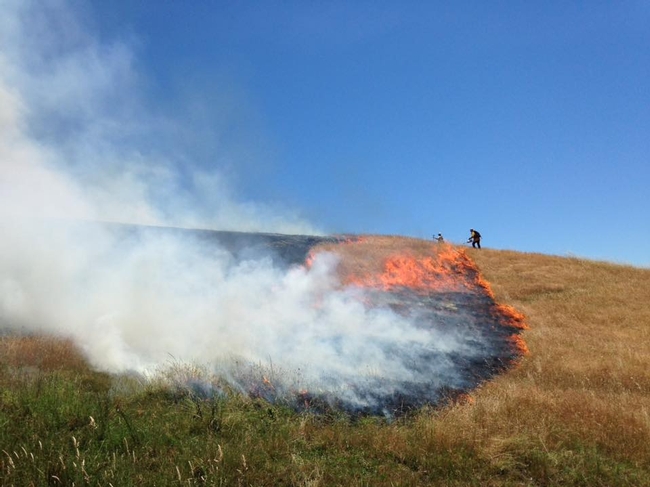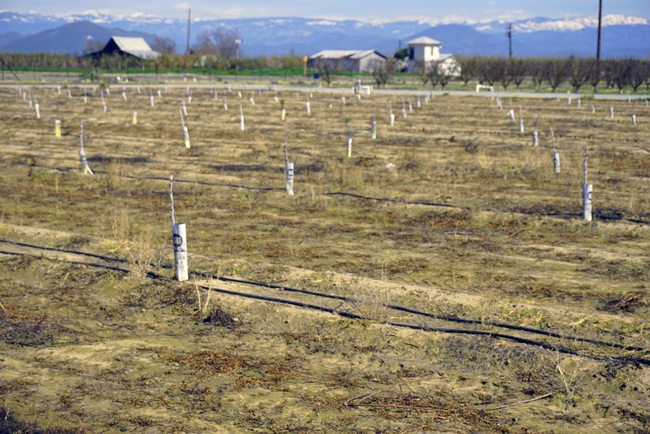Posts Tagged: Weeds
Suppliers, retailers warn California grape growers of herbicide shortages
Supply-chain crisis forces some to pivot to mechanical, biocontrol measures
Driving through her vineyards on a chilly morning in December, Hortencia Alvarado is taking comfort – for now – that the weeds she sees are all yellow. But there remains a nagging worry that, like the pesky plants, is merely lying dormant for the season.
When March rolls around, and the first signs of new green growth appear on the vines, Alvarado and other vineyard managers will again have to confront the ongoing shockwaves of the global supply-chain crisis.
Growers of grapes – the third-highest valued agricultural commodity in California at $4.48 billion in 2020 – likely won't be able to access the herbicides that they usually apply.
“I definitely need to start thinking and considering it because I don't want to be in that situation where I don't have [the herbicide] when I need it,” said Alvarado, a vineyard manager in the San Joaquin Valley.
Imperfect alternatives
She first noticed the effects of the shortages this past August, during the application following the harvest of early varietals. Alvarado's agricultural pest control adviser had recommended a different product, instead of their usual standby, Rely – because none of the handful of suppliers in California could find it.
Then Alvarado's foreman started reporting that the substitute wasn't controlling the weeds.
“We were using some other stuff that wasn't as good, so basically we were wasting money on stuff that wasn't doing what we wanted it to do,” Alvarado explained.
The need for more machines or labor is just one result of the herbicide shortage, said George Zhuang, University of California Cooperative Extension viticulture farm advisor in Fresno County. Zhuang has received “a lot” of calls from growers about the chemical supply issues, which are also affecting fertilizers. He's been urging them to move away from traditional herbicides to mechanical means or biocontrol such as sheep or fowl – even though they might be more expensive.
Zhuang estimates that while a weed program comprises 5% to 10% of total production costs in a normal year with the usual herbicides, the use of nonchemical alternatives could hike that percentage up to 10% to 20%. In addition to their impact on the bottom line, effective herbicides are especially crucial to grape growers because vines – unlike tree crops – cannot naturally shade out weeds with expansive canopies.
“Right now, people can still scramble around and find some limited chemicals to make sure the crop is successful for the harvest, but if the situation goes for another year, I think there's going to be a panic in farming communities,” Zhuang said.
Herbicide challenges expected to linger
Unfortunately, the availability of certain products is likely going to be “challenged” into at least the middle of 2022, according to Andy Biancardi, a Salinas-based sales manager at Wilbur-Ellis, an international marketer and distributor of agricultural products and chemicals. Biancardi said that the suppliers he talks to are advising people to make preparations.
The supply of glyphosate, the key component in products such as RoundUp (used by many Midwestern farmers), appears to be most affected, Biancardi said. As a result, that shortage has put the squeeze on alternatives such as glufosinate, used in products like Rely – the herbicide favored by many California grape growers.
“The cost of glufosinate has definitely gone up because there just isn't enough, so everyone is obviously marking it up,” said Biancardi, who estimates that prices for both glyphosate and glufosinate are up 25% to 30% for growers.
Alvarado said that while large commercial operations are able to pay the premium prices or shift to other weed control measures, some smaller growers have essentially given up the fight – simply letting the weeds take over.
“They're just letting it go wild until the dormant season,” she said. “They're hoping that – by when they do start to spray [around March] – they'll hopefully have that Rely.”
Silver lining to supply crisis?
Large-scale growers and retailers are buying up those scarcer products when they can, in anticipation of future shortages during critical times. Biancardi said that while his company traditionally runs inventories down at the end of the season, they are instead stocking up on herbicides that customers will demand.
“Careful planning and forecasting is going to be more important than ever, that's really the key,” he said. “At this point we can't guarantee ‘business as usual,' based on what we're hearing.”
Shaking off old habits might actually bring some benefits to business, according to Alvarado, as a forced shift away from chemicals could prove to be a selling point for customers, from a sustainability and marketing standpoint.
“Out of this shortage, there might be some good, some wins,” she said, “but at the same time, we're going to need some answers – I think it's going to be a bumpy road.”
Calling the confluence of drought, record heat and a shortage of chemicals a “perfect storm,” Zhuang said that consumers could start feeling those jolts as well.
“Eventually, somebody is going to eat the costs – either the farming community or the consumer is going to eat the cost, I hate to say it,” he said.
UC launches WeedCUT, a new online tool to manage invasive weeds in wildlands without herbicides
California has abundant wildlands — forests, rangeland, open areas, wildlife refuges and national, state, and local parks — that need protection from invasive plants. Invasive plants affect all Californians by increasing wildfire potential; reducing water resources; accelerating erosion and flooding; threatening wildlife; degrading range, crop and timberland; and diminishing outdoor recreation opportunities. According to the California Invasive Plant Council (Cal-IPC), more than 200 identified plant species harm California's wildlands.
Cal-IPC and the University of California Statewide Integrated Pest Management Program (UC IPM), with funding from the California Department of Pesticide Regulation (DPR) Alliance Grants Program, developed two resources that provide land managers access to the latest information on non-herbicide practices for managing weeds in wildlands. Best Management Practices for Non-Chemical Weed Control is a free downloadable manual. The same information has been incorporated into an interactive online tool called WeedCUT (Weed Control User Tool: weedcut.ipm.ucanr.edu).
"We anticipate WeedCUT will increase the use of more mechanical, physical, or biological practices, and potentially result in the reduction of herbicides used to manage wildland invasive weeds," said area IPM advisor emeritus Cheryl Wilen. "Best Management Practices for Non-Chemical Weed Control and WeedCUT were developed so land managers can become more knowledgeable and skilled in the use of non-herbicide methods as part of an IPM program.”
Best Management Practices for Non-Chemical Weed Control provides comprehensive descriptions of 21 commonly used non-herbicide weed control techniques and biological control agents for 18 invasive plants. Each chapter is the synthesis of research and on-the-ground knowledge from practitioners about non-herbicide methods. The chapters describe how a technique is best applied, the types of invasive plants and environmental conditions where it is most effective, and what its shortfalls might be. Environmental, cultural, and human safety risks are highlighted to help support the safe and effective use of these methods.
WeedCUT is the online version and can be used to learn about the different non-herbicide management methods, including the section on biological control. To filter through the database and learn which management practice to consider for a particular site and invasive plant type, a simple interface allows users to pick characteristics that describe their site and invasive plant problem. The tool then filters through the database to display the practices ranked by efficacy (excellent, good, fair, poor or ineffective). As in the manual, use of the technique and potential hazards are covered.
Best Management Practices for Non-Chemical Weed Control and WeedCUT are designed to be the go-to resources for practitioners that complement their conventional weed management work with non-herbicide techniques or are restricted in their use of herbicides. Both resources will help practitioners manage weeds more effectively.
“Many experts in the field have contributed to create the manual and WeedCUT. It has been exciting to see these techniques described and reviewed so carefully. We're looking forward to seeing land managers, as well as all folks fighting weeds, incorporating the information from the manual and WeedCUT into their work,” said Jutta Burger, science program director and project lead with Cal-IPC.
While the manual and tool focus on non-herbicide methods, the hope is future funding can be found to continue the work and integrate herbicide options online.
"Land managers typically use both herbicide and non-herbicide methods, alone and in combination, to manage invasive plants in wildlands," said UC Cooperative Extension advisor and UC IPM-affiliated advisor Tom Getts. "A tool that combined both herbicide and non-herbicide methods would guide land managers to determine the most effective overall management program for their particular site."
California’s bad romance with Bromus fuels wildfire
When wildfires burn in California, people often call them forest fires or brushfires, but the odds are high that an invasive weed is an unrecognized fuels component, says a UC Agriculture and Natural Resources scientist.
“We have all of the nasty non-native Bromus species here in California, and these weeds are key drivers of increasing fire frequency,” said Travis Bean, UC Cooperative Extension weed science specialist based at UC Riverside.
The invasive, non-native Bromus species aggressively outcompete native plants, forming dense stands that grow fast and dry out quickly, becoming highly flammable. Fire can move rapidly through these dense patches of dry grass, especially during windy conditions or on slopes.
“When you have understory of dry Bromus or other weedy grasses, their ease of ignition can allow fire to spread from areas like roadsides where ignition sources are plentiful to more pristine native plant communities,” Bean said. “Additionally, these fast-moving fires can throw embers that allows the fire to jump long distances or even reach high into the air, igniting structures.”
Identifying fire fuel
Bean would like to see the fuels in wildfires identified so people have a chance to consider managing them to mitigate the increasing frequency of catastrophic wildfire across the state.
With training, citizen scientists such as California Naturalists could help cities, counties, utilities and government agencies identify the invasive plant species that fuel urban wildfires.
“On a landscape scale, I would focus on managing Bromus anywhere human-caused ignitions occur,” Bean said. “Resources for management are scarce, and these species are widespread and can't be controlled everywhere they occur. Roadsides, hiking trails, and campgrounds are critical areas where people can start fires that spread, so It makes sense to concentrate management there.”
Cheatgrass (Bromus tectorum) is widespread at higher elevations, while ripgut brome (B. diandrus) and red brome (B. madritensis spp. rubens), also called foxtail brome, are pervasive at lower elevations. Along with other invasive winter annual weeds, they have successfully replaced large areas of the native vegetation in Southern California.
“When I talk to land managers about these species, they recognize that some areas will have to be sacrificed and it may not be possible to eliminate these species from the landscape,” Bean said. They are prioritizing areas with smaller invasive populations where there is an actual chance to eliminate them, or are managing larger populations for containment so they don't spread.”
Timing is everything
The key to reducing the spread of invasive, non-native Bromus species or any annual weed is preventing the plants from producing seeds, Bean said. “Whatever control method you chose, if deployed too early or too late, you gain nothing for considerable expense.” Too early and the plants may simply resprout, while too late and they will have already set seed and further contributed to next year's weed crop.
Herbicide is an effective and inexpensive means of control, though many prefer non-chemical methods. Hand pulling can be effective in small areas, but is discouraged for large patches due to the sheer amount of labor required and risks of actually spreading the weed seeds.
Another way land managers can try to prevent the weeds from spreading is by mowing or grazing with goats, sheep or cattle, Bean said, adding that using livestock can require more intensive management and proper timing is critical.
“For mowing and grazing, the key is to wait until the plants have started to flower, but the seeds are not mature,” Bean said. “If you mow when there's mature seed, you'll just spread the seed and make the problem worse. And once the seedheads mature, grazing animals won't eat it.”
Prescribed fire is another option for containing invasive grasses, but is generally discouraged as there's a very high chance of exacerbating the problem. These Bromus species are very fire-adapted and tend to increase following burns. Prescribed fire should only be used by professional land managers. If this strategy is used, a burn plan, permits and training are essential. If not done correctly, prescribed burns may escape control and become wildfires, producing smoke that impairs visibility on highways, impacts air quality and human health, and damages native vegetation.
“Timing is everything,” Bean said, explaining the temperature difference between the plant and soil surface. “The grass has to be dry enough to carry fire, but not so dry that the seeds have fallen from the plant to the soil surface, where temperatures are much cooler than just a few inches up in the air where the seedheads are. Some research has shown this strategy to have been successfully used for certain invasive grasses like barb goatgrass (Aegilops triuncilias), but is not recommended for Brome species.”
He expects the changing climate to lead to more invasive plant species. “Invasive plants can be more resilient during drought and can quickly bounce back when rain returns, overwhelming natives,” Bean said. “And invasive species are often key drivers of wildfires and increasing fire frequencies and intensities, which prevents the recovery of native plants.“
November News Clips (11/1-11/14)
As wildfires grow deadlier, officials search for solutions
(Associated Press) Matthew Brown and Ellen Knickmeyer, Nov. 14
…"There are ... so many ways that can go wrong, in the warning, the modes of getting the message out, the confusion ... the traffic jams," said Max Moritz, a wildfire specialist with the University of California Cooperative Extension program.
As deadly urban wildfires become more common, officials should also consider establishing "local retreat zones, local safety zones" in communities where residents can ride out the deadly firestorms if escape seems impossible, Moritz said.
… In the mid-20th century, California ranchers burned hundreds of thousands of acres annually to manage their lands, said Lenya Quinn-Davidson, director of the Northern California Prescribed Fire Council.
That was phased out in the 1980s after California's fire management agency stepped in to take over the burns, and by the last decade, the amount of acreage being treated had dropped to less than 10,000 acres annually, Quinn-Davidson said.
Former agricultural land that rings many towns in the state became overgrown, even as housing developments pushed deeper into those rural areas. That was the situation in the Northern California town of Redding leading up to a fire that began in July and destroyed more than 1,000 homes. It was blamed for eight deaths.
"You get these growing cities pushing out - housing developments going right up into brush and wooded areas. One ignition on a bad day, and all that is threatened," Quinn-Davidson said. "These fires are tragic, and they're telling us this is urgent. We can't sit on our hands."
http://www.kulr8.com/story/39483128/fatal-california-fires-spur-search-for-solutions
Camp Fire vs. Tubbs Fire: The two most destructive fires in California history
(San Francisco Chronicle) Amy Graff, Nov. 14
Comparing California's most destructive wildfires -- the current Camp Fire and last year's Tubb's Fire -- College of Natural Resources Dean Emeritus Keith Gilless, also a forest economics professor, says: "One fundamental difference that occurs to me is that the Tubbs fire broke out late at night, which made notification and evacuation particularly difficult." Professor Gilless also discussed California's wildfires on WBUR's On Point program.
Trump and Brown stir up rhetoric on wildfires but overlook pressing problems
(LA Times) Bettina Boxall, Nov. 14
… “I've been following these issues for 40 years, and I don't remember a time when the issue of wildfire has ever been politicized anywhere close to the extent it is now,” said Richard Frank, director of the California Environmental Law and Policy Center at UC Davis.
… Similarly, UC Berkeley fire scientist Scott Stephens said that although climate change is playing a role in wildfire growth, he worries that a focus on global warming can leave the public thinking that “there's really nothing to be done.”
In fact, he said, “Communities could still be better prepared.”
http://www.latimes.com/local/lanow/la-me-fire-policy-trump-brown-20181114-story.html
Staggered evacuation plan questioned in fire's aftermath
(Associated Press) Paul Elias, Kathleen Ronayne, Nov. 14
…Paradise sits on a ridge between two higher hills, with only one main exit out of town. The best solution seemed to be to order evacuations in phases, so people didn't get trapped.
“Gridlock is always the biggest concern,” said William Stewart, a forestry professor at the University of California, Berkeley.
…Likewise, Stewart, the forestry professor, said the wildfire that hit Paradise disrupted the orderly evacuation plan because it “was moving too fast. All hell broke loose.”
He said experts continue to debate how best to issue evacuation orders and no ideal solution has been found.
Blueberry growers focus on open market window
(Ag Alert) Padma Nagappan, Nov. 14
…It makes sense to tap the market earlier in the year, when California growers are not competing with others entering the market and there are better margins to be had. That's why Ramiro Lobo and others from the University of California have been working on a long-term berry trial in Southern California, to look for the best varieties that can be produced early in the year.
"You have to be in the market as early as you can, because by April and beginning of May, the prices are so low, it doesn't even pay for the harvest," Lobo said. He is a small farms and agricultural economics advisor with UC Cooperative Extension.
http://www.agalert.com/story/Default.aspx?id=12300
Sanitation is foundation of Navel orangeworm control
(Farm Press) Logan Hawkes, Nov 14
So far this year, early estimates reveal that nut damage and subsequent losses from NOW larvae, will be less than in 2017, though the pest remains a major concern in almond, pistachio, and even walnut orchards. University of California Agriculture and Natural Resource (UC-ANR) advisors note that a successful management plan for controlling Navel orangeworm starts in the fall following harvest and continues through the winter months.
"Sanitation is the foundation of Navel orangeworm control," says Pheobe Gordon of UC Cooperative Extension. "Post-harvest sanitation is the first step in slowing the emergence of the pest when the new season begins."
… UC-ANR Extension IPM Specialist Dr. Jhalendra Rijal is one of the leading researchers on Navel orangeworm control in almonds and walnuts. "We have been working vigorously to better understand Navel orangeworms, how they reproduce, migrate, and survive,” he says.
https://www.westernfarmpress.com/tree-nuts/sanitation-foundation-navel-orangeworm-control
How Does California's Wildlife Cope With Massive Wildfires?
(Atlas Obscura) Anna Kusmer, Nov. 13
While many animals are indeed displaced by wildfires, it's important to note that fire is not wholly bad for landscapes in an ecological sense. In fact, many California ecosystems rely on fire to thrive. “Fire in the human sense can often be catastrophic, but it's not necessarily the same for animals,” says Greg Giusti, a retired University of California researcher and an expert on the relationship between wildfires and wildlife. He says California wildlife have evolved to respond to fires, and can even sometimes benefit from the disruption. “It's harsh out there, but you know these animals have evolved to survive in that hostile environment.”
There are a variety to survival tactics that California wildlife will use, says Giusti. For example, birds are easily able to fly away and are usually not impacted as long as fires don't occur during the spring when they are nesting and raising their offspring.
https://www.atlasobscura.com/articles/how-does-californias-wildlife-cope-with-massive-wildfires
The Manmade Causes Of California's Endless Fire Season
(OnPoint) Meghna Chakrabarti, Nov 13
California's endless fire season. Whether it's climate change, development or forest management, we'll look at the causes — all manmade.
Guests:
Scott McLean, deputy chief, chief of information for the California Department of Forestry and Fire Protection.
Ryan Lillis, reporter for the Sacramento Bee who has covered most of Northern California's fires for last 12 years. (@Ryan_Lillis)
J. Keith Gilless, professor of forest economics at University of California, Berkeley and chair of the California Board of Forestry and Fire Protection on Cal Fire's policy board.
Glen MacDonald, professor of geography at University of California, Los Angeles who has spent decades studying climate and the effects of wildfires. He and his family were among the hundreds of thousands of people who evacuated their homes because of the Woolsey Fire. (@GlenMMacDonald1)
http://www.wbur.org/onpoint/2018/11/13/californias-endless-fire-season-climate-change
California Must Better Prepare For The Inevitability Of Future Fires
(Pacific Standard) Max Moritz, Naomi Tague & Sarah Anderson, Nov 13
Wildfire has been an integral part of California ecosystems for centuries. Now, however, nearly a third of homes in California are in wildland urban interface areas where houses intermingling with wildlands and fire is a natural phenomenon. Just as Californians must live with earthquake risk, they must live with wildfires.
https://psmag.com/environment/california-must-better-prepare-for-future-fires
Forest management debate
(KTVU) Heather Holmes, Nov. 12
In a live interview, Bill Stewart, UC Cooperative Extension specialist at UC Berkeley, said,
“It was actually on the private land that we saw better performance in terms of being able to put out the fire quicker and a lot less smoke being produced. There is a package of vegetation management and fire suppression on private lands that have proved to be more effective than what's being used on federal land.
“What we found is about half the difference comes from the private land managers do more aggressive timber harvesting and some of that profit they spend to reduce the shrubs and fuels that are on the ground because they have that cashflow. They're protecting their long-term assets. The other half is CALFIRE is much more aggressive when it comes to fire suppression in forests or shrublands.
http://www.ktvu.com/news/372545595-video
Trump Right? Hack-and-Squirt the Forest. Created the Huge California Fire Hazard
(Mary Greeley News) Mary Greeley, Nov. 12
On average, the cost of thinning forests through hack-and-squirt while leaving the dead trees standing is about $250 per acre, said Greg Giusti, a forest advisor with the University of California Cooperative Extension. The cost of cutting and leaving them on the ground is about $750 an acre, while cutting and hauling them away is about $1,000 an acre.
https://www.youtube.com/watch?v=tEOETb7ttaY
Trump's Misleading Claims About California's Fire ‘Mismanagement'
(New York Times) Kendra Pierre-Louis, Nov. 12
…Mr. Trump is suggesting that forest management played a role, but California's current wildfires aren't forest fires.
“These fires aren't even in forests,” said Max Moritz, a wildfire specialist at the University of California, Santa Barbara.
…“We have vulnerable housing stock already out there on the landscape. These are structures that were often built to building codes from earlier decades and they're not as fire resistant as they could be,” Dr. Moritz said. “This issue of where and how we built our homes has left us very exposed to home losses and fatalities like these.”
https://www.nytimes.com/2018/11/12/us/politics/fact-check-trump-california-fire-tweet.html
Carbon Farming Initiative Takes Tentative First Steps in Santa Ynez Valley
(Noozhaw) Garrett Hazelwood, Nov. 12
On a recent morning in the Santa Ynez Valley, a crowd of people gathered at the Ted Chamberlin Ranch to discuss soil health and so-called carbon farming.
The event –– hosted by the Community Environmental Council, the Cachuma Resource Conservation District, and the Santa Barbara Agricultural Commissioner's Office –– showcased successful carbon farming trials recently conducted on the ranch, and was attended by local landowners, environmental activists, scientists and county officials.
Matthew Shapero, Livestock and Range Advisor for the UC Cooperative Extension, explained that the grasses surrounding the site had sprouted green last spring and have since died in the heat of summer, becoming what he calls “residual dry matter.” Now the brittle, golden shoots have become a sparse cover for hard-packed soil that's cracked and dry.
California's year-round wildfire threat: Why aren't communities doing more?
(SF Chronicle) Peter Fimrite and Kurtis Alexander Nov. 10,
…“To have a president come out and say it's all because of forest management is ridiculous. It completely ignores the dynamic of what's going on around us.” said LeRoy Westerling, a climate and fire scientist at UC Merced, who blamed the increasing number of fires on rising temperatures and more variable precipitation, leading to longer spells of dry weather.
…“It's like a tragic replay of last year, with strong winds in both Northern California and Southern California blowing fire,” said Max Moritz, a wildfire specialist at the Bren School at UC Santa Barbara, recalling the 2017 Wine Country fires and the Thomas Fire, which burned through Ventura and Santa Barbara counties in December.
…“We had a lot of discussion after the fires last year about the liability issue with utilities, but it's interesting to see what didn't happen,” Moritz said. “Nobody has talked about mapping neighborhoods and homes in fire-prone areas like they do in flood plain hazard zones, engineering resilience into communities, or building a little smarter.”
…Everybody agrees the situation is dire. Fire officials blame shorter winters, hotter temperatures and drier vegetation, but very little is being done to improve the situation, said Scott Stevens, a professor of fire science at UC Berkeley.
“There is an under-appreciation of fire risk in a lot of communities,” Stevens said. “It feels like we can do better at allowing local communities to access information, reduce their vulnerability and understand their vulnerability a little bit more.”
Stevens urged the creation of cooperative programs at his and other universities that would allow local government officials to collaborate with fire experts on safety planning.
California's most destructive wildfire should not have come as a surprise
(LA Times) Bettina Boxall and Paige St. John, Nov. 10
…“We have these Santa Ana-like events happening in places that are appearing to catch people by surprise,” said Max Moritz, a cooperative extension wildfire specialist at UC Santa Barbara's Bren School. “But they shouldn't be catching people by surprise.”
“These are areas that have burned before,” he said. “And if we were to go back and do the wind mapping, we would find that at some intervals, these areas are prone to these north and northeasterly Santa Ana-like events.”
… “We have all kinds of tools to help us do this smarter, to build in a more sustainable way and to co-exist with fire,” he said. “But everybody throws up their hands and says, ‘Oh, all land-use planning is local. You can't tell people that they can't build there.' And the conversation stops right there.”
http://www.latimes.com/local/lanow/la-me-camp-fire-science-20181110-story.html
Are Organic Farms Ruining California's Rural Coast?
(Pacific Standard) Laura Fraser, Nov. 9
David Lewis, county director of the UC Cooperative Extension in Marin County, estimates that the Point Reyes ranches contribute as much as 20 percent of the county's $110 million in annual agricultural production. Given the industries that support agriculture—feed companies, veterinary services, a grass-fed beef butchery—the overall economic output of the ranches may be three times that amount. If the ranches closed, Lewis says, "You'd be losing about $60 million a year in production." The ranchers also contribute more than 5,000 jobs in the region, on and off the farms.
https://psmag.com/.amp/environment/are-organic-farms-ruining-california-rural-coast
Countries Embrace Genome Editing in Contrast of EU's Opinion
(AgNet West) Brian German, Nov. 8
The United States joined 12 other nations to encourage policies to enable continued agricultural innovation, including genome editing. Australia, Canada, Brazil, and Vietnam were among the countries issuing support of the International Statement on Agricultural Applications of Precision Biotechnology. Noticeably absent from the joint statement of support was the European Union (EU).
…“Ideally, or in theory, regulations are meant to be in place to address risk. And so the more risk, the more regulation and the less risk the less regulation,” said Alison Van Eenennaam, Animal Genomics and Biotechnology Specialist at UC Davis. “But in this case, it's just regulation triggered by a particular process irrespective of the risk of the product.”
http://agnetwest.com/countries-genome-editing-contrast-eu/
University of California's Glenda Humiston wins 2018 California Steward Leader Award
(CA Economy) Nadine Ono, Nov. 8
Glenda Humiston has always been involved in rural issues from her days growing up on a farm to her current position as vice president of University of California Division of Agriculture and Natural Resources.
“I was really involved in the 1990s in trying to figure out how agriculture and environmental interests find common ground, as well as building bridges between rural and urban sectors," said Humiston. "In the 2000s, I started focusing on economic development and sustainability. In my current job, I'm bringing all of those together around the reality that sustainability truly has to be a triple bottom line. We've got to develop ways for people, the planet and prosperity to all thrive and enhance the synergies between them."
Humiston will be awarded the 2018 California Steward Leader Award at the California Economic Summit. She currently serves on the 2018 Economic Summit Steering Committee, as well the Action Team co-lead for Working Landscapes and co-chair of the Elevate Rural California initiative.
Instances of Bindweed Popping Up in Central Valley Farms
(AgNet West) Brian German, Nov. 7
Waterhemp is continuing to cause some concern in and around Merced County, but there is another problematic weed species that growers should be aware of and remain on the lookout for. “Bindweed is actually a big problem throughout the central valley of California,” said Agronomy and Weed Science Advisor for Merced and Madera Counties, Lynn Sosnoskie. “It's really a concern particularly where we have crops that are grown on drip irrigation and reduced tillage systems.”
http://agnetwest.com/bindweed-popping-central-valley-farms/
Agriculture group to hear from extension speaker
(Ventura County Star) Nov. 7
The Ventura County chapter of California Women for Agriculture will host a presentation by Annemiek Schilder of the University of California Cooperative Extension and Hansen Agricultural Research and Extension Center.
Minorities Are Most Vulnerable When Wildfires Strike in U.S., Study Finds
(New York Times) Kendra Pierre-Louis, Nov. 3
…The study, which appears in the journal PLoS One this month, suggests that people of color, especially Native Americans, face more risk from wildfires than whites. It is another example of how the kinds of disasters exacerbated by climate change often hit minorities and the poor the hardest.
…Rachel Morello-Frosch, a professor of environmental health at the University of California, Berkeley, said the research could be useful in preparing for future disasters. “Results of this study can help inform planning and outreach efforts to enhance the resilience of fire-prone communities, particularly for communities of color that are often overlooked when these disasters happen,” she said in an email.
https://www.nytimes.com/2018/11/03/climate/wildfires-minorities-risk.html
Wildfire Risk A Key Issue In California Insurance Commissioner Race
(Capital Radio) Ezra David Romero, Nov. 2
…"I recently talked to a homeowner who had his insurance canceled about three months before his house was destroyed by a wildfire,” said UC Cooperative Extension forestry and natural resources advisor Susan Kocher.
Kocher says calls from homeowners come often, and that people's reality is something the new commissioner will have to deal with: a complicated insurance system and a warming climate that's increasing the number, size and impact of fires in California.
A New Hue
(California Bountiful) Kevin Hecteman, Nov. 1
… C. Scott Stoddard, a University of California Cooperative Extension farm advisor in Merced County, is running trials with different purple varieties, working in concert with a sweet potato breeder at Louisiana State University.
One recent test variety, he noted, started off well from a color and yield standpoint a couple of years ago, but the interior color wasn't quite purple enough—he was getting more of a lavender potato.
"We are still very experimental," Stoddard said. "There's nothing that looks like it's going to have something there any time soon."
http://www.californiabountiful.com/features/article.aspx?arID=2204
Eating right learned at school
(Roseville Press Tribune) Carol Feineman, Nov. 1
More than 25 percent of youth ages 5 to 19 are overweight in Placer and Nevada counties, according to University of California CalFresh Nutrition Education Program, Placer/Nevada counties. The program is part of the University of California Cooperative Extension.
UC CalFresh is trying to lower that percentage by offering nutrition classes for adults and also teaching some Roseville, Lincoln and Sheridan public school students how to eat healthier. The organization also works with area school gardens.
…“As students get older, they're making more of the choices themselves. So many kids end up being home by themselves or packing their lunch,” said Rosemary Carter, UC CalFresh program manager for Placer-Nevada Counties. “I want them to understand what the healthy foods will do for their bodies. I want them to make the healthy choices, to make an educated choice.”
http://www.thepresstribune.com/article/11/01/18/eating-right-learned-school
Why the FDA's plan to regulate gene editing in animals has some scientists worried
(Pacific Standard) Emily Moon, Nov 1
…While genetically engineered animals have been met with controversy, animal geneticist Alison Van Eenennaam believed her own work would be immune. In her lab at the University of California–Davis, Van Eenennaam uses genetic editing technology to develop cows without horns. The process, she says, is no different than traditional breeding, in which breeders select for naturally occurring mutations. "Nature does this routinely, because there are always breaks getting introduced into double-stranded DNA by radiation and sunlight and alcohol, you name it," she says. "That's how evolution happens."
Researchers raise concern over paraquat health risks
The popular herbicide paraquat works well and is inexpensive, but emerging research shows a correlation of paraquat exposure and Parkinson's disease, reported Kerry Klein on Valley Public Radio.
Klein met with UC Cooperative Extension weed advisor Kurt Hembree at an almond orchard near Selma that was clear of weeds. Growers kill weeds because weeds kill crops, Hembree said.
"Direct competition for water and nutrients. Whatever the tree likes, the weeds like," he said.
Hembree explained how the paraquat works.
"Paraquat's a contact-type herbicide," he said. "In other words, it's a material that, if you sprayed it on a plant, it'll disrupt the plant's cells. And basically in five or six days, whatever it touches, it spots up and it causes necrosis and death on the tissue."
Paraquat is toxic, so it requires careful handling to protect the safety of applicators.
“Something like paraquat, you're going to wear rubber boots, you're going to wear goggles while you're spraying,” Hembree said. “You don't want to get this stuff on your skin or on your mouth or anywhere.”
The KVPR story said paraquat is among the top 10 most common herbicides in California, and the San Joaquin Valley gets more than three-quarters of the state total. Caroline Tanner, a neurologist at UC San Francisco, was also interviewed for the story.
“People who mixed or applied this chemical had more than double the risk of developing Parkinson's disease compared to people really very similar as far as where they lived, even what they did for a living, age and gender,” she said.
However, people who were careful with personal protective equipment didn't have a greater risk of Parkinson's disease, Tanner said.

